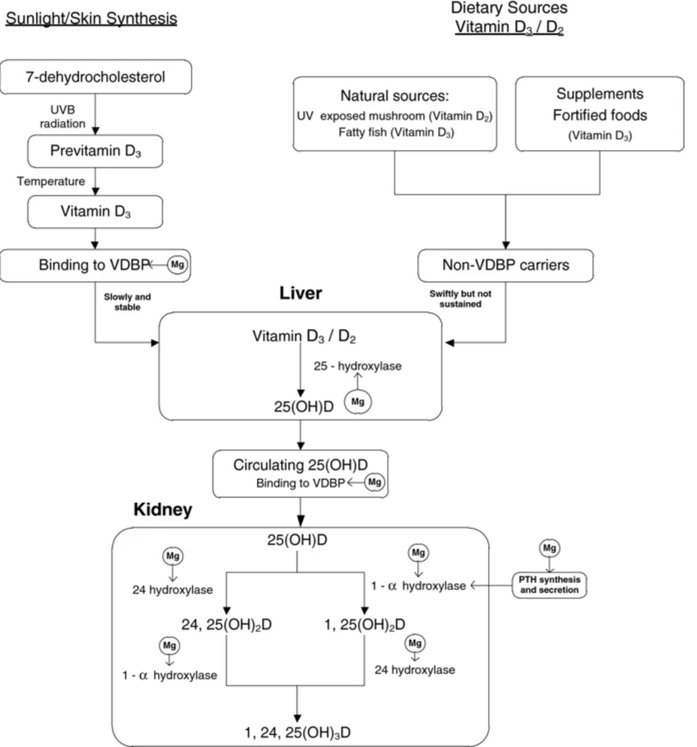Vitamin D, Magnesium, and Calcium are Co-Nutrients
In a previous blog on the GrassrootsHealth website, the value of magnesium as a co-nutrient for Vitamin D was mentioned:
Co-nutrients are nutrients that work together for some process. If one co-nutrient is limited, either missing or not plentiful enough, then the process might also be limited. For example, your body needs magnesium for vitamin D metabolism; without sufficient magnesium, the amount of vitamin D that can be metabolized and used by your body is limited.
Let’s explore this further so that you understand the value of supplementing magnesium and Vitamin D together and then deciding whether your diet contains enough calcium.
Magnesium and Vitamin D Metabolism
The paper “Magnesium, Vitamin D Status and Mortality” in the BMC Medicine displays a detailed flow chart of vitamin D metabolism, which shows that magnesium is required in 8 crucial steps.

Magnesium and metabolism of vitamin D. PTH, parathyroid hormone; UVB, ultraviolet B; VDBP, vitamin D binding protein. https://bmcmedicine.biomedcentral.com/articles/10.1186/1741-7015-11-187#Fig1
This is vital information that every doctor prescribing vitamin D and every person taking vitamin D needs to know and needs to act on. Further, while the investigators called for more studies, their preliminary findings indicated that:
it is possible that magnesium intake alone or its interaction with vitamin D intake may contribute to vitamin D status.
Low Vitamin D and Low Magnesium Increase Risk
From the existing literature, we know that low vitamin D increases the risk of mortality and morbidity and that magnesium plays an essential role in vitamin D metabolism. Putting these two facts together, researchers in a 2015 study investigated whether magnesium intake modifies the serum 25(OH)D3 concentration and its association with mortality in middle-aged and older men. The study included 1,892 men ages forty-two to sixty without cardiovascular disease or cancer. They concluded that low serum 25(OH)D3 concentration was associated with increased risk of death mainly in those with lower magnesium intake.
The Dynamic between Vitamin D, Magnesium, and Calcium
[Photo of 3 Dancers]
Magnesium expert Andrea Rosanoff, Ph.D., is one of the very few people who understands th[e] dynamic between vitamin D, magnesium, and calcium. She makes this the topic of her 2016 paper called “Essential Nutrient Interactions: Does Low or Suboptimal Magnesium Status Interact with Vitamin D and/or Calcium Status?”, Andrea lists the problems encountered when trying to define this interaction in this Abstract:
Although much is known about magnesium, its interactions with calcium and vitamin D are less well studied. Magnesium intake is low in populations who consume modern processed-food diets. Low magnesium intake is associated with chronic diseases of global concern [e.g., cardiovascular disease (CVD), type 2 diabetes, metabolic syndrome, and skeletal disorders], as is low vitamin D status. No simple, reliable biomarker for whole-body magnesium status is currently available, which makes clinical assessment and interpretation of human magnesium research difficult.
Here, she further discusses magnesium:calcium intake ratios:
Between 1977 and 2012, US calcium intakes increased at a rate 2-2.5 times that of magnesium intakes, resulting in a dietary calcium to magnesium intake ratio of >3.0. Calcium to magnesium ratios <1.7 and >2.8 can be detrimental, and optimal ratios may be ∼2.0. Background calcium to magnesium ratios can affect studies of either mineral alone. For example, US studies (background Ca:Mg >3.0) showed benefits of high dietary or supplemental magnesium for CVD [“cardiovascular disease”], whereas similar Chinese studies (background Ca:Mg <1.7) showed increased risks of CVD.
Additionally, Rosanoff recommends further study of the implications of low magnesium status with calcium and vitamin D:
Oral vitamin D is widely recommended in US age-sex groups with low dietary magnesium. Magnesium is a cofactor for vitamin D biosynthesis, transport, and activation; and vitamin D and magnesium studies both showed associations with several of the same chronic diseases. Research on possible magnesium and vitamin D interactions in these human diseases is currently rare. Increasing calcium to magnesium intake ratios, coupled with calcium and vitamin D supplementation coincident with suboptimal magnesium intakes, may have unknown health implications. Interactions of low magnesium status with calcium and vitamin D, especially during supplementation, require further study.
Vitamin D Is a Prohormone
In the Endocrine Society’s article on Vitamin D, they explain that Vitamin D is a Prohormone:
[T]he truth is, this often-misunderstood “vitamin” is not a vitamin — it is a prohormone. Prohormones are substances that the body converts to a hormone. In fact, unlike other vitamins, only about 10 percent of the vitamin D the body needs comes from food (such as dairy products and oily fish), and the rest the body makes for itself. Understanding this hormone and the role it plays in the body will help you make informed health decisions.
Vitamin D is a hormone the kidneys produce that controls blood calcium concentration and impacts the immune system.
The Intricate Dance among Magnesium and Calcium
The antagonistic relationship between magnesium and calcium is described by M. H. Tao in this study:
Magnesium and calcium antagonize each other in absorption, reabsorption, cell cycle regulation, inflammation, and many other physiologic activities.
Of even further importance is the presence of magnesium to regulate calcium, as noted by BM Altura in their 2001 study:
Since magnesium is necessary to regulate calcium, when magnesium is deficient, it’s the excess calcium that creates vascular spasms and pathology.
That is why a 1:1 ratio between magnesium:calcium, when you supplement magnesium is crucial to maintain balance between these two nutrients.
My Suggestions
When you acknowledge the complexity of the relationships among Vitamin D and magnesium (Vitamin D metabolism), Vitamin D and calcium (Vitamin D control blood calcium concentration), and calcium and magnesium (antagonistic relationship that regulate absorption, etc.), you can see how important all three co-nutrients are in partnership. I’ve previously written that most people get plenty of calcium in their food (I suggest using the WHO RDA for calcium of 600 mg per day.). With respect to magnesium and Vitamin D supplementation, GrassrootsHealth testing is the perfect opportunity to get a baseline of where you are, supplement the Vitamin D and magnesium you might need, and retest in 6 months.
